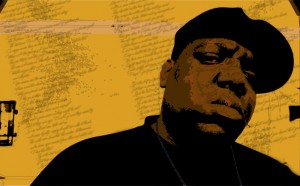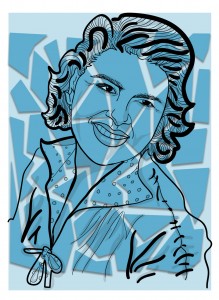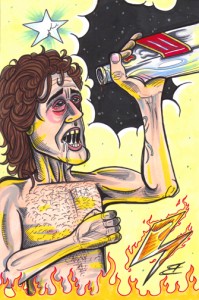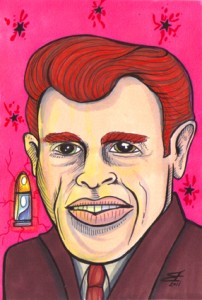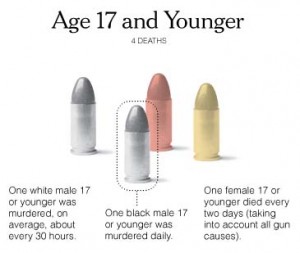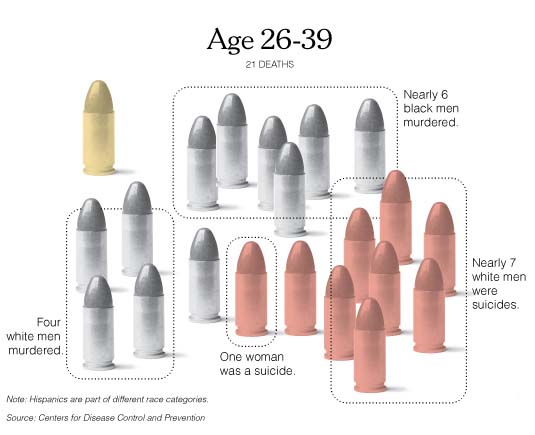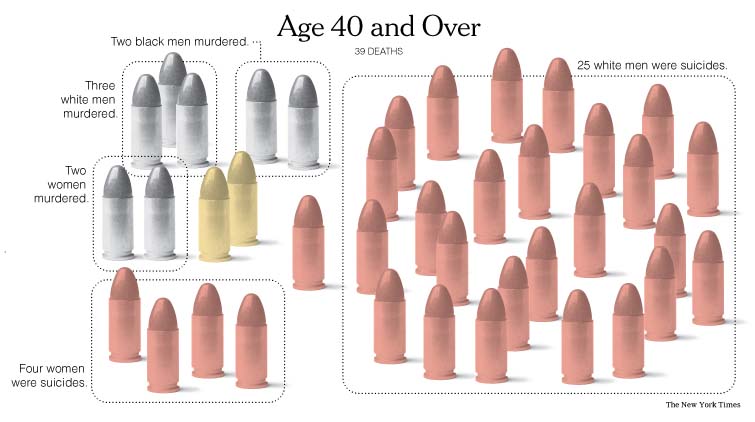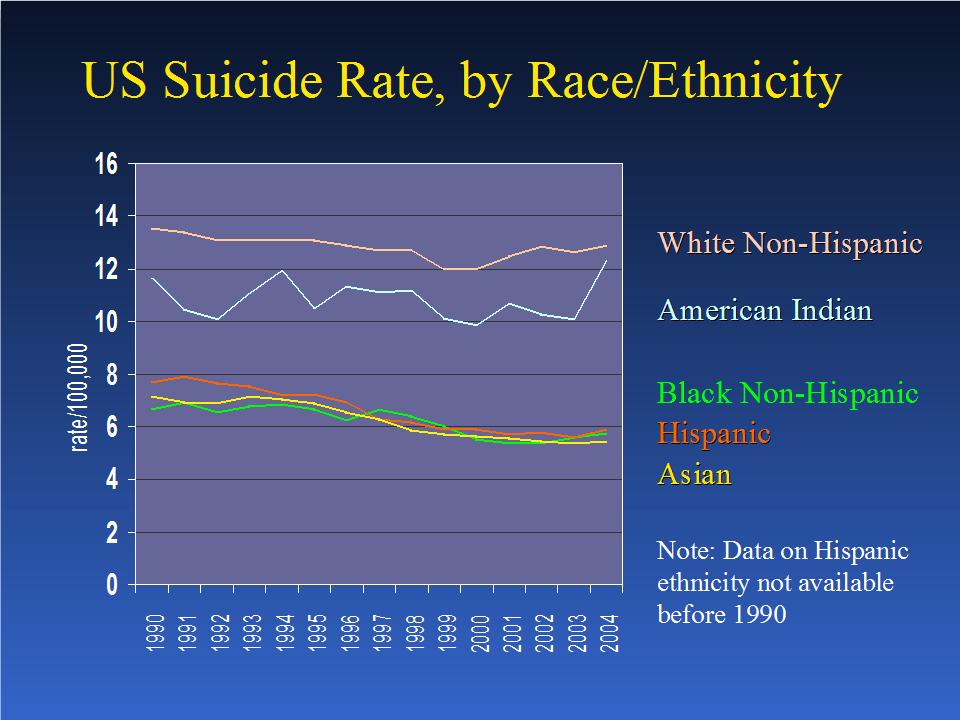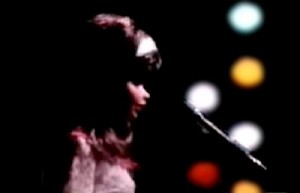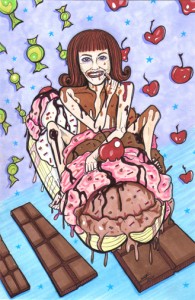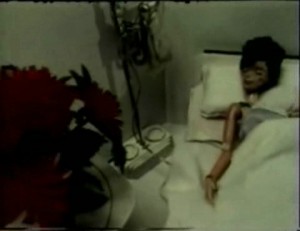It is dawn on Biggie Small’s deathday, and I’m sitting in the safest place in St. Louis, MO—just in case you care. I’ve been climbing in an unfamiliar arena ceiling for days now, 100′ in the air. Steel beams and rough company. Most people consider this to be a dangerous occupation, but apparently my walk to the hotel was the riskiest move I’ve made all night.
The television blares in the hotel lobby—the news shows a S.W.A.T. team kicking in doors in south St. Louis. A well-dressed, effeminate white man talks about how the neighborhood is really coming together through “community activism.” Thugs wave guns at the news crew. The two hotel security guards shake their heads in disdain.
I point to the screen and ask the motherly night clerk, Kay, “What would happen if I took a pleasant evening stroll down that street?”
“Boy, you betta not let the sun set on yo’ white ass down there.”
According to my guardians—two large black men with big flashlights and security badges—St. Louis has the # 1 murder rate in the U.S.A. “Why do people kill each other so much?” I ask.
“You know. Fool ganstas. Drugs. Husbands killin’ wives. Wives killin’ husbands. Stoopid shit.” My sleepy-eyed protector shrugs and sips his coffee.
This #1 status is a slight exaggeration. According to FBI statistics, St. Louis is actually just behind New Orleans in the bloody competition for “most bullet-sprayed city.” However, East St. Louis—when considered as its own entity—is leaps and bounds beyond NOLA in the murder race, with 101.9 people murdered for every 100,000 in 2006. (The national average is about 6 in 100,000.) Morticians must get a lot of overtime around here.
“Yeah, people take fools to tha East Side to kill ‘em,” the security guard explains, ”and they bring they dead bodies and dump ‘em ovah here.”
“That’s what happened to my nephew,” says the night clerk, Kay. “He thought he was livin’ the life. Drugs, gangs, you know. They drove him into East St. Louis. He felt that hot lead and he jumped out that car—right outta his shoes.” Kay shakes her head sadly. “He can’t see no mo’. Shot seven times in tha face. But he still with us.”
Kay is paid to be nice to me, but after a couple of hours of conversation, I’m pretty sure she would be nice to me anyway. She brings me my own urn of coffee, which is not bad for hotel brew. She knows I have to go to work after I write this, and tells me, “Stop chattin’ and get typin’!”
It’s hard to end a conversation with Kay. She knows more about dead rock stars than anybody I have met in months. We talk about Sid Vicious’ murderous temper tantrum, and the brutal shooting of squeaky clean (accused rapist) Sam Cooke. Kay talks about the Day Michael Jackson Died, and how shocked she was that the late Farrah Fawcett was immediately booted out of the spotlight the moment the King of Pop hit the hospital. And of course, Kay is well-versed in the canonical teachings of the patron saints of the East and West Coasts, whose lyrics meet like ram horns in the Midwest.
“There’s two kinds of people: those who love 2Pac, and those who love B.I.G.”
I would have said, “And then there’s me,” but that’s not completely true. My first deathday article was about the Notorious B.I.G., entitled “The Death Day of Biggie Smalls.” Man, what a clever headline.
Biggie was a bright kid—an honor role student who made his mother proud. Then he started hawking hubs, sporting furs and fedoras, and spittin’ dope rhymes. Smart, ambitious, and fat as all hell, he soon metamorphosed from Christopher Wallace to the Notorious B.I.G. Harlem star-maker, Sean “Puffy” Combs, got a hold of him, and B.I.G. became 350 pounds of bold lyrics and brash suicide trips.
Maintaining the morbid themes of his debut album, Ready to Die, Biggie’s posthumous release features a number of precient songtitles, such as “Somebody’s Gotta Die,” “Last Day,” “Niggas Bleed,” and of course, “You’re Nobody (‘Til Somebody Kills You)”. At 24 years-old, Biggie became a self-created emblem for ghetto violence.
Biggie represented Brooklyn at the height of the East Coast-West Coast rap wars during the 1990s. On March 9, 1997, he was killed in a hail of bullets at an L.A. intersection—six months after his friend-turned-rival Tupac Shakur was gunned down in a similar fashion. While accusations have been hurled at everybody from Suge Knight to the FBI, his murderers remain at large. Maybe thugs were hired by Deathrow Records. Or maybe his murder was the result of composing too many death songs—a manifestation of his morbid imagination, like in Rhonda Byrne’s The Secret, but bloodier.
I ask Kay what she thinks happened to Biggie.
“I think Puffy Combs had him killed. That’s just my opinion. But Puffy be sleazy, the way he continued to capitalize on Biggie’s death. Then he got caught up in that club shoot-up with Shyne [one of Puffy's rapper protégés, who was convicted of the shooting while Puffy walked free]. Puff Daddy probably just had Biggie popped fo’ tha money.”
She has a point. Perhaps Biggie was just a big, black piñata full of dollar bills, and Puffy came swinging a stick with no blindfold.
I don’t know if it took a bullet to make Biggie a legend, but his death certainly seems fated in retrospect. Even orchestrated. I recently saw his image displayed at the acclaimed “Who Shot Rock n’ Roll?” exhibit when it passed through Columbia, SC. Taken a few weeks before his death, the photograph features B.I.G. in silvery black-and-white, standing in funerary attire among a hundred thousand anonymous tombstones. The message: Everyone dies, but celebrities get to keep their faces. Would Biggie have faded into a featureless grave if his life had been spared?
Kay snatches up my printout of last year’s Biggie Smalls article and starts reading. I’m apprehensive at first, but she loves it. She even reads this passage aloud:
“Released two weeks after his death, Life After Death sold over ten million copies. P-Diddy crawled out from that blood-splattered Californian intersection like an Alien chestburster and grew into a hype-spinning monster that still stalks the earth in search of more dollars.”
She especially loves the ending, and I’m thinking, thank God somebody does.
“As long as there are fools, they will imitate their heroes. And as long as their heroes portray braggadocious murderers, fools will continue to kill each other like morons with sharp sticks.
“So I’m throwing on my cream suit and hat, and heading out to the club. I’ll love it when you call me Big Poppa. And if you point a gun at me, I suppose I’ll throw my hands in the air, like I’s a true player.”
© 2011 Joseph Allen
